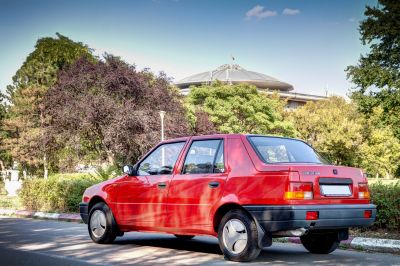 1981 Volkswagen Derby (86C) Dimensions, Size & Specs
1981 Volkswagen Derby (86C) Dimensions, Size & SpecsMeasurements of the 1981 Volkswagen Derby, engineered for optimal performance and comfort
| Dimensions | |
|---|---|
| Length: | 3975 mm156.5 in13.0 ft |
| Width: | 1580 mm62.2 in5.2 ft |
| Height: | 1355 mm53.3 in4.4 ft |
| Ground Clearance: | 118 mm4.6 in0.4 ft |
| Trunk Capacity: | 445 liter15.7 cu ft |
| Weight Specifications | |
| Curb Weight: | 715-735 kg1576-1620 lbs |
| Maximal permitted Weight: | 1150 kg2535 lbs |
| Roof Load: | 50 kg110 lbs |
| Tire Specifications | |
| Rims Size: | 13-inch rims:
|
| Tire Size: |
|
The Volkswagen Derby (86C), produced between 1981 and 1984, is a compact sedan that exemplifies the efficient design and engineering of early 1980s Volkswagen models. Measuring 3975 mm (156.5 inches) in length, 1580 mm (62.2 inches) in width, and standing 1355 mm (53.3 inches) tall, the Derby is tailored for urban practicality and compact comfort. Its curb weight ranges between 715 and 735 kg (1,576 to 1,620 lbs), making it a lightweight vehicle that supports nimble handling and fuel efficiency. The maximum permissible weight for the Derby is 1150 kg (2,535 lbs), ensuring it can carry passengers and cargo safely without compromising performance.
One of the practical highlights of the Volkswagen Derby is its luggage capacity of 445 liters (around 15.7 cubic feet), providing ample space for everyday needs or small trips, while the roof load limit is set at 50 kg (110 lbs), allowing additional cargo options if needed. The ride height or ground clearance is 118 mm (4.6 inches), offering a balance between road handling and comfort on a variety of surfaces. The vehicle runs on 4.5J x 13 inch rims, fitted with tires sized 145/80 R13, typical for compact sedans of its time, ensuring a smooth and stable ride.
As a four-door sedan variant of the Volkswagen Polo platform, the Derby blends compact dimensions with practical sedan characteristics, appealing to drivers seeking a small-sized car with the added benefit of a traditional boot trunk instead of a hatchback. Its dimensions and weight make it ideal for navigating crowded city streets and tight parking spaces, while offering enough interior and cargo space for daily commuting and small family use. The VW Derby remains a notable example of Volkswagen's commitment to creating versatile, economical, and accessible vehicles during the early 1980s.
Discover the standout features that make the 1981 Volkswagen Derby a leader in its class
Have a question? Please check our knowledgebase first.
The Volkswagen Derby (86C) produced from 1981 to 1984 has precise exterior dimensions designed for a compact sedan profile. The car measures 3975 mm (approximately 156.5 inches) in length, offering a manageable size for city driving and parking. It has a width of 1580 mm (about 62.2 inches), providing a balance between interior room and ease of maneuverability. The height of the Derby is 1355 mm (around 53.3 inches), contributing to its aerodynamic silhouette and low center of gravity. These dimensions reflect the typical compact sedan size of the early 1980s, designed for practicality and efficiency.
The Volkswagen Derby (86C) is relatively lightweight, with a curb weight ranging between 715 kg and 735 kg (approximately 1576 to 1620 pounds). This light weight contributes to the car's efficiency and nimble handling characteristic of small sedans of its era. The maximum weight rating or gross vehicle weight is 1150 kg (about 2535 pounds), allowing a substantial payload when accounting for passengers and luggage. This weight specification ensures the vehicle remains safe and stable under maximum load conditions without compromising performance or safety.
The Volkswagen Derby (86C) offers a substantial luggage capacity of 445 liters (approximately 15.7 cubic feet), which is generous for a compact sedan from the early 1980s. This spacious trunk allows owners to carry daily errands' loads or moderate travel gear with ease. Its practicality stands out, particularly because many cars from this era and size category had less storage room. The relatively large boot capacity is advantageous for both urban use and longer trips, ensuring that the car can accommodate a family's luggage or grocery shopping needs efficiently.
Yes, the Volkswagen Derby (86C) generally fits well into a standard garage space. Given its length of 3975 mm (156.5 inches) and width of 1580 mm (62.2 inches), it is compact enough to fit into typical single-car garage spaces, which are usually about 2.4 to 3 meters (7.9 to 9.8 feet) wide and around 5.4 to 6 meters (17.7 to 19.7 feet) long. Its relatively low height of 1355 mm (53.3 inches) also ensures clearance under most garage doors. The compact dimensions make parking and storage in urban or residential garages convenient without requiring extra space accommodations.
The Volkswagen Derby (86C) has a ride height or ground clearance of 118 mm (about 4.6 inches), which is typical for compact sedans that are designed primarily for paved roads and city driving. This clearance allows the car to maintain a low center of gravity for better handling and stability but may limit off-road capability over uneven terrain or deep potholes. While this low clearance contributes to better aerodynamics and fuel efficiency, drivers should be cautious on rough roads to avoid undercarriage damage. Overall, the ground clearance suits the Derby's urban and suburban usage profile excellently.
The Volkswagen Derby (86C) comes equipped with 4.5J x 13 rims paired with 145/80 R13 tires. This configuration is well-matched for the car's compact size and weight, offering a balanced ride quality. The 13-inch wheels provide adequate sidewall height on the tires for absorbing road irregularities, contributing to comfort over typical road surfaces. The relatively narrow 145 mm tire width aligns with fuel efficiency goals and ease of steering, while the 80 aspect ratio ensures enough cushioning. Overall, this tire and rim setup strikes a good compromise between comfort, handling, and economy.
The Volkswagen Derby (86C) effectively succeeded the Volkswagen Polo Saloon version but featured updates that influenced size and weight. Compared to its predecessor, the Derby maintained compact dimensions but offered slight refinements in length and width for increased interior space and practicality. In terms of weight, the Derby stayed light at around 715–735 kg, similar to or slightly heavier than previous Polo-based models due to added features and structural enhancements. Compared to contemporaries like the Volkswagen Polo, the Derby was designed as a sedan alternative with a similar footprint but more emphasis on trunk space and comfort.
When compared with similar compact sedans from the early 1980s, such as the Ford Fiesta Mk1 saloon or the Opel Kadett C sedan, the Volkswagen Derby (86C) showcased competitive dimensions. At 3975 mm in length (156.5 inches), it was on par with these rivals, typically ranging between 3900 mm to 4100 mm. Its width of 1580 mm (62.2 inches) was also comparable if not slightly narrower, aiding in urban maneuverability. Additionally, the Derby's luggage capacity of 445 liters was relatively generous among compact sedans, making it a practical choice. Overall, dimensionally and in terms of weight, the Derby held its own well against contemporaries.
The Volkswagen Derby (86C)'s compact dimensions contribute significantly to ease of parking and maneuvering in tight urban environments. Its length of just under 4 meters (3975 mm) and narrow width allow drivers to fit into smaller parking spaces and navigate through congested city streets comfortably. The relatively low weight (715-735 kg) enhances agility and responsiveness, making it easy to handle. Plus, with a ride height of 118 mm, it maintains a low profile for better aerodynamics and fuel efficiency, which suits daily commuting needs perfectly. The spacious luggage capacity further adds to its practicality.
The Volkswagen Derby (86C) has a maximum roof load capacity of 50 kg (approximately 110 pounds). This capacity allows drivers to safely carry additional items such as roof boxes, luggage racks, or sporting equipment on the roof without risking structural damage or affecting driving safety. While 50 kg is not extraordinarily high, it is adequate for typical accessory loads. When combined with its maximum vehicle weight of 1150 kg, this enables users to make the most of the Derby's practical carrying capabilities, maximizing cargo space and flexibility for trips or daily errands.
Discover similar sized cars.

| Production: | 1995-2003 |
|---|---|
| Model Year: | 1995 |
| Length: | 4030 mm158.7 in |
| Width: | 1640 mm64.6 in |
| Height: | 1390-1430 mm54.7-56.3 in |
